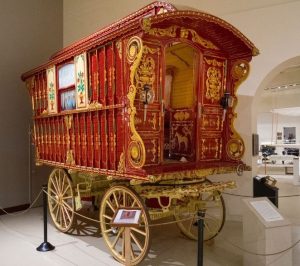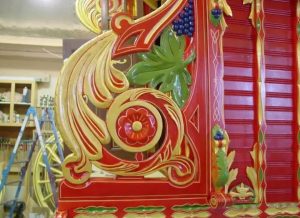Around the fourteenth century, a group known as the Romani immigrated from northern India to Europe.
They crossed the continent in carriages, much like the Roths, and traveled to Great Britain as well as North America, Brazil, and Australia. In these wagons, which they referred to as vardo, wagons, vans, or caravans, several Romani communities traveled and resided.
They were typically pulled by horses and had golden highlights and vivid decorations. From the middle of the 18th century to the beginning of the 20th, British Romani were regarded as having the most artistic designs.
Victoria’s creative painting abilities and interior design, which make use of silk, satin, velvet, and lace, are displayed in the Roths’ caravans. The couple constructs, carve, and paint their entire caravan themselves.
Wally and Victoria offer their works of art as a little home, guest house, art studio, meditation or healing place, or just as a charming addition to a backyard, despite the fact that their designs are not intended to be transported down the road.

Photo Credits – Respective Owner
The body of a vardo has big wheels outside of it, and its sides slope outward significantly as it rises to the eaves. In addition to this feature, the six different types of caravans vary in size, form, and location of the wheels in relation to the bed, maker, and maker’s location.
The bow-top and open-lot varieties’ roofs are made of canvas stretched over curved wooden frames, while the others are made of wood. Nearly all of the designs were standardized by the middle of the 18th century, and all types share some features. Almost always, the door is in the front.
Small cast-iron cooking stoves are a common feature of wagons since they were developed in America, were marketed there and in Great Britain starting around 1830, and were invented there. A chimney is necessary for venting smoke from a cooking stove.
From the front doorway, a caravan’s chimney is always on the left side of the vehicle; in this location, the chimney is less vulnerable to low-hanging tree limbs as the vehicle moves along the left side of the road. A wooden fireplace supports the stove.

Romanichal Chiriklo door carving in the traditional style (bird). Early 20th-century Vardos were ornately painted, hand-carved, and artistically ornamented with traditional Romani symbols, according to reading vardo.
Jim Berry, John Pockett, Tom Stevens, Tommy Gaskin, and John Pickett are among the artists who contributed to the early development of vardo art. Modern contemporary decorators who have continued to define this vibrant heritage include Yorkie Greenwood and Lol Thompson.
The carvings, which featured Romani cultural elements like horses and dogs as well as typical artistic designs of birds, lions, griffins, flowers, vines, and intricate scrollwork, were a large part of the vardo’s treasure on show.
Gold leaf was frequently used to decorate carved details, either by painting it on or, in the case of the most expensive wagons, applying 4–15 books of gold leaf. The distinctive designs of many separate makers could be recognized.
What do you think of this masterpiece design? Please let us know in the comments, and don’t forget to spread the news so that we can hear from more people.


